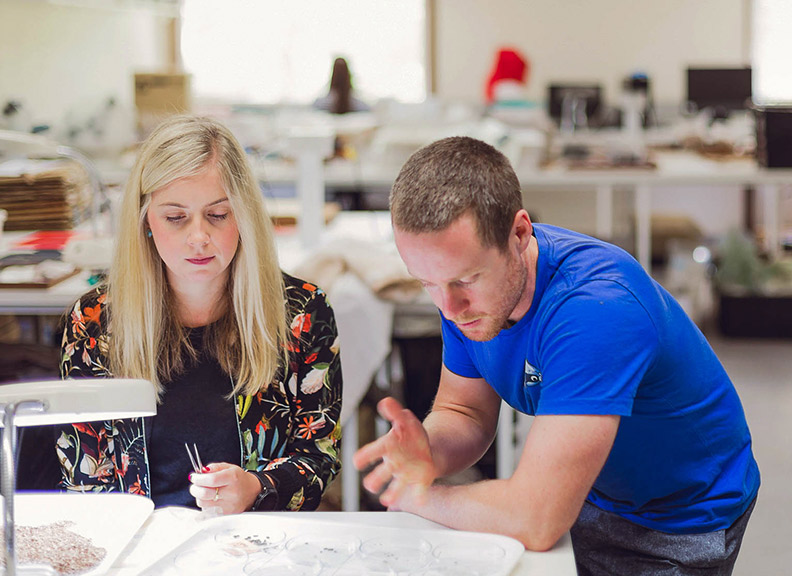PROJECT
Pacific Matildas: Finding the women in the history of Pacific archaeology
Started at UWA: 2020
Re-framing history: Acknowledging women who pioneered archaeology in the Pacific
25 years ago, one female pioneer and historian of science, Margaret Rossiter, called for future scholars to, “write a more equitable and comprehensive history and sociology of science that not only does not leave all the ‘Matildas’ out, but calls attention to still more of them”. Rossiter confronted the historical process through which female scientists were ‘written out of history’, coining the phrase, ‘the Matilda effect’.
Pacific Matildas: Finding the women in the history of Pacific archaeology, responds to Rossiter’s plight. The project aims to investigate the scientific lives of the first women who conducted archaeological work in Oceania from the late 19th to the mid-20th century, and document their hidden contributions to the development of Pacific archaeology, to ensure their stories and legacies become part of broader narratives in the history of science.
An interdisciplinary approach will be developed to document the hidden role of women in the history of archaeology and identify mechanisms that led to the relative historical invisibility of their contributions.
This project is a continuation from a previous Australian Research Council (ARC) Laureate Project based at the Australian National University (ANU) on the History of Archaeology in the Pacific. Dr Emilie Dotte-Sarout, lead investigator of the Pacific Matildas project, has been a postdoctoral research fellow contributing to The Collective Biography of Archaeology in the Pacific from 2015 to 2020.
Anticipated outcomes of this project include:
- a more inclusive history that provides diverse role models for women in science from our region.
- the identification of socio-cultural patterns limiting women's careers and successful strategies historically developed to overcome these.
Project opportunity
We welcome researchers to join our team, including people interested in using this area to drive a PhD. Activities will include designing and contributing to a database of publications on historical women pioneers investigated in this project.
Goals
Advance knowledge in the history of Pacific archaeology by re-establishing the participation of women in the discipline.
Implement an interdisciplinary approach to overcome and identify the reasons for the relative ‘invisibility’ of women in the history of archaeology.
Determine socio-cultural barriers historically faced by women in practising Pacific archaeology, and successful strategies they developed in response.
Work with us
This project involves research that will be conducted in collaboration with Pacific research institutions, communities and those interested in contributing to better recognition of the first women archaeologists of the Pacific. Volunteers can assist with establishing an EndNote library database of publications of historical women figures investigated in the project.
If you’d like to get involved, contact Dr Emilie Dotte-Sarout on the details below.
News
Forgotten characters of the history of archaeology
Emilie Dotte-Sarout presented a public conference on her current research on the essential roles played by Elizabeth Shutler and the Kanak fieldworkers
Read moreIndo-Pacific Prehistory Association – November 2022 Congress
The Pacific Matildas team presented their current research in the session ‘ A Hidden History? Women in the History of Indo-Pacific Archaeology Before 2000’ at the 22nd IPPA Congress
Read moreAt the Heart of the Polynesian Triangle
Emilie Dotte-Sarout presented the Pacific Matildas project at the University of French Polynesia, in French for local students and public
Read moreInvisible no more – putting the first women archaeologists of the Pacific back on the map
Pacific Matildas focuses on the stories of the first women in the field, understand the barriers they faced and highlight their legacies.
Read moreResearch team
Research team leader
Dr Emilie Dotte-Sarout is a DECRA Research Fellow at UWA. She specialises in Pacific archaeology and the history of archaeology, and has been working as an archaeobotanist studying the relationship between people and their vegetal environment in Oceania.
Research assistant
Dr India Ella Dilkes-Hall is a promising early career Australian archaeologist and archaeobotanist. Dr Dilkes-Hall worked on the Pacific Matildas project to create databases of published outputs by or about professional women archaeologists working in the Pacific region generating quantitative and qualitative data about their representation in academia.
PhD scholar
Sylvie Brassard is undertaking a PhD under the Pacific Matilda project. Originally from Quebec and a long-time resident of Australia with a background in French History, Sylvie will be investigating the untold story of the team of voluntary assistants and students who worked behind the scenes with Marie-Charlotte (Manouka) Laroche in the Musée de l’Homme during the formative years of the French School of Pacific Archaeology (from the end of the 1930s to the 1970s). She will be working within the School of Humanities and highlighting the interdisciplinary aspects of the project.
Quitterie Puel started her PhD under the Pacific Matilda Project in late 2021. With a background in Heritage Studies and experience working in Museums or Cultural institutions, including in the Pacific, Quitterie will be looking at the hidden strings behind a group of women who pioneered the anthropological study of string-figures, or cat’s cradles, throughout the Pacific region during the first half of the 20th century. String figures were used as a specific form of both material and immaterial cultural items demonstrating possible links between islands – they were once used in archaeological arguments about migrations paths and peopling of the Pacific. Yet, the role played by these women, their striking connections and the specific relations they built with Indigenous experts, remain largely forgotten by the field.
Publications
An interview with the The French Australian review: The Matilda Effect in Archaeology
Dotte, E., 2023, In: The French Australian review. 73, p. 116 124 p.
A new chapter in the massive open access volume produced by the CBAP project:
Aurora Natua and the Motu Paeao site: Unlocking French Polynesia’s islands for Pacific archaeologists
Dotte, E., Maric, T. & Molle, G., 2022, Uncovering Pacific Pasts: Histories of Archaeology in Oceania. Howes, H., Jones, T. & Spriggs, M. (eds.). Canberra: ANU Press, p. 469-487
An exhibition and catalogue with the Musee des Explorations du Monde de Cannes:
Dessiner au bout du Monde: le regard d'Adèle de Dombasle, aventuriere et illustratrice au 19e siecle: Exhibition Catalogue; French-English bilingual volume
Jaillet, T., Dotte, E., Molle, G., Claus, G. & Ligner, S., 2022, Cannes: Musee des Explorations du Monde de Cannes. 59 p.
A keynote and chapter as part of a special conference around the heritage of the Pastor Leenhardt in New Caledonia:
Maurice – et Jeanne – Leenhardt et l’archéologie calédonienne : une histoire de connections
Translated title of the contribution: Maurice - and Jeanne Leenhardt - and the archaeology of New Caledonia: a story of connections, Dotte, E., 2021, Maurice Leenhardt (1878-1954): Contextes et héritages. Barbe, D., Graille, C. & Murphy, G. (eds.). University of New Caledonia, p. 64-86
Archaeology Week
Funding
Databases
Pacific Matildas Bibliographic Database (PMBD)
The PMDB is a legacy project created by Dr India Ella Dilkes-Hall for the ARC funded DECRA Project Pacific Matildas: finding the women in the history of Pacific archaeology awarded to Dr Emilie Dotte-Sarout. The PMDB assists in making the written outputs produced by women*, identified as Pacific Matildas (PM), visible and accessible by producing an online resource that creates a comprehensive overview of literature significant to their research or research they contributed to.
Hosted on Zotero, a fully accessible online public library sharing platform, the PMDB compiles around 2,000 references spanning three centuries (i.e. from Rose de Freycinet c. 1817 to Janet Davidson 2019) and has several valuable features for others interested in the history of Pacific Matildas in the development of archaeology as a discipline in the Pacific region.
- Each entry is catalogued according to PM name
- Where possible, entries contain an abstract or brief description to help researchers identify relevant content
- Where possible, entries contain tags (keywords) that can be used to form sub-groups
* Women who identify themselves or are identified by others as women. We recognise this is a problematic term that may not be reflective of what the Pacific Matildas themselves identified as. For more discussion of the project’s approach on this, see Dotte-Sarout, E., 2021. Pacific Matildas: Finding the Women in the History of Pacific Archaeology. Bulletin of the History of Archaeology, 31(1), p.2. DOI: http://doi.org/10.5334/bha-656
Note: an Excel spreadsheet is also available for direct download allowing for an alternative quick search and find option and a compressed version of the original Endnote library (prior to transfer to Zotero) is available on request. For further information please contact Emilie Dotte.
Citation
Dilkes-Hall, IE and E Dotte-Sarout 2021 Pacific Matildas Bibliographic Database. Accessed [insert date] from <insert URL>.
Creative commons
Copyright Statement: © India Ella Dilkes-Hall and Emilie Dotte-Sarout, 2021. Licensed under a CC BY-SA license.
The Pacific Matildas Bibliographic Database (PMBD) can be accessed here.
Pacific Matildas Geographical Visualisation (PMGV)
The PMGV is another legacy project created by Dr India Ella Dilkes-Hall for the ARC funded DECRA Project Pacific Matildas: finding the women in the history of Pacific archaeology awarded to Dr Emilie Dotte-Sarout, to be used in association with the PMBD. Hosted on Google Maps, it locates the research outputs created by the work of Pacific Matildas on different Pacific islands, and literally places the first women archaeologists back on the map.
Notes for users
The PMGV is broken into four major layers (regions) Micronesia, Melanesia, Polynesia* (excluding New Zealand), and New Zealand. These layers can be turned on and off by checking the box next to the layer title.
Within each of the four major layers, points are used in reference to research locations. Where possible points have been placed as close as possible to where original research was carried out. Where this hasn’t been possible a more general placement has occurred.
At the first instance, the research location is given followed by the last name of the Pacific Matilda (e.g. Kapingamarangi [Davidson]). Place names used by Pacific Matildas are given first with currently accepted (often English) name separated by / (e.g. Ponape / Pohnpei).
Different and specific colours are used for each researcher identified by the project (n = 50). Points are arranged alphabetically with points of the same colour underneath the first referring to the same Pacific Matilda. Where possible, and where applicable, the colours used for each PM have been used across the four major layers. Although this has not always been possible due to the limited colour palette available (PM = 50, colours available = 30).
Clicking on specific points will reveal a reference/s to relevant works of the researchers, which you can then search for through the PMBD on Zotero (these may not always be works authored by the Pacific Matildas themselves but references to works by others that acknowledge their contribution). Where multiple references are given // is used to separate them.
It is important to note that some PMs research was carried out without visiting the Pacific (e.g. Eilers, Schurig) nonetheless to factor in their contributions, where possible, the locations of original research (carried out by others) have been added.
* Creators recognise the colonial and racist underpinnings of the tripartite racial division system in the Pacific region. We acknowledge the pain this has caused Indigenous groups across to Pacific. The division, as used here, is not employed as a racial division but a purely geographical division.
Note: For users who wish to utilise PMGV and build upon it further a KML export option is available on request. For further information please contact Emilie Dotte
Citation
Google, nd. Geographical Visualisation created by India Ella Dilkes-Hall, 2021, for ARC Project Pacific Matildas: Finding the women in the history of Pacific archaeology. Accessed [insert date] from <insert URL>.
Creative commons
Copyright Statement: © India Ella Dilkes-Hall and Emilie Dotte-Sarout, 2021. Licensed under a CC BY-SA license.
The Pacific Matildas Geographical Visualisation (PMGV) can be accessed here.
Postgraduate student research projects
We are offering specific research projects for PhD, Masters of Research or Honours applicants interested in History, Anthropology, Archaeology and Heritage studies:
- The growing impact of ‘that shadowy band’: A history of women’s engagement in 20th century Australian and New Zealand archaeology.
Other topics will be available to postgraduate students to investigate the work undertaken in the Pacific by pioneer women in fields of study cognate to archaeology: focusing on (i) specialists in material culture studies or (iii) ‘folklorists’ - many of whom being indigenous scholars.
PhD and Masters applicants must meet academic criteria for the Research Training Program scholarship, and have a background in either Australian or Pacific archaeology, history, gender studies, Pacific or Australian studies, museum and material culture studies, with interdisciplinary interests. Recommended readings:
- Rossiter Margaret W. ‘The Matthew/Matilda Effect in Science’, Social Studies of Science London, 23 (2): 325–341: 1993
- Murray T. & Spriggs M. ‘The historiography of archaeology: exploring theory, contingency and rationality’, World Archaeology, 49 (2): 151-157: 2017
Higher degree by research (HDR) scholarships are available for application. Applications for the Domestic/UWA International Graduates Postgraduate Research Scholarships Round for commencement in 2021 are open from 1 September to Friday 30 October 2020. More information can be found via the Graduate Research School. Additional project funding may assist conference attendance and fieldwork costs, including carer responsibilities. Please contact Emilie Dotte-Sarout if you are interested.



